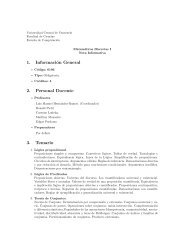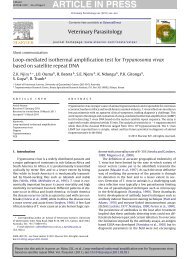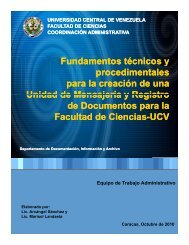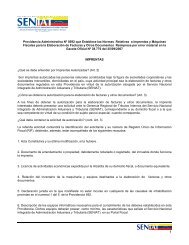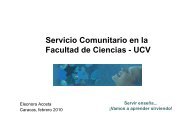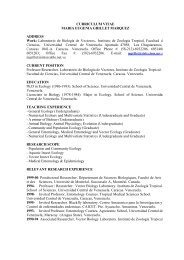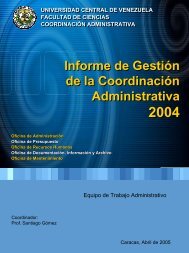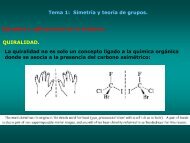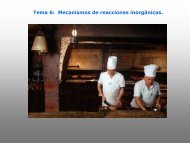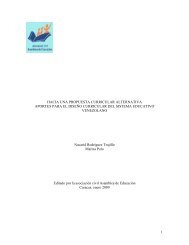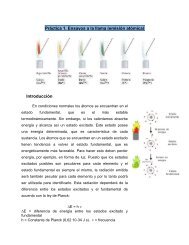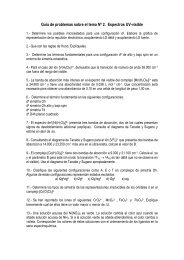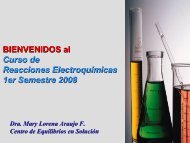Collecting and Preserving
Collecting and Preserving
Collecting and Preserving
- No tags were found...
You also want an ePaper? Increase the reach of your titles
YUMPU automatically turns print PDFs into web optimized ePapers that Google loves.
or placed on triangles after this treatment.Warning: Xylene is now considered to be carcinogenic.A new <strong>and</strong> already widely used chemical, Histo-Clear, is a promising substitute.Reference: Sabrosky 1966.3.3 - Direct PinningThis section pertains entirely to insects becausemites should never be mounted on pins. Direct pinningrefers to the insertion of a st<strong>and</strong>ard insect pin directlythrough the body of an insect. Only insect pins should beused; ordinary straight pins are too short <strong>and</strong> thick <strong>and</strong> alsohave other disadvantages. St<strong>and</strong>ard insect pins are 38 mmlong <strong>and</strong> range in thickness from size 000 to 6 or 7. Headsare now commonly made of nylon, but they may be of atype called “upset,” that is, an integral head is made bymechanically squeezing out the end of the pin, or a smallpiece of metal is pressed onto the pin. A well-made upsethead is considered by some entomologists to be best; otherkinds of heads sometimes come off, leaving a sharp pointthat easily can pierce a finger. Recently, however, pinshave become available with nylon heads attached ratherfirmly. Pins of No. 2 diameter are most useful (0.46 mm indiameter). Most entomologists avoid the very slender pinsof size 000 to 1, preferring to use double mounts (see p.28), but now that soft polyethylene or plastic foam iscommonly used for pinning bottoms in trays <strong>and</strong> boxes,these smaller sizes are not so impractical as formerly. Pinsof larger diameter, Nos. 3-7, may be needed for largeinsects.St<strong>and</strong>ard insect pins are currently made of eitherordinary spring steel, which is called ‘black,’ or stainlesssteel <strong>and</strong> with either a blued or a lacquered (japanned)finish. The black pins may corrode or rust with even slightexposure to moisture or to the body contents of the insects.Although the stainless steel pins are more expensive thanblack pins, their being rustproof makes them desirable foruse in permanent collections. However, their points aresomewhat more easily turned than those of black pins inpiercing an insect with a hard cuticle, <strong>and</strong> they are not asrigid. For that reason, it is sometimes advisable to piercean insect having an especially hard cuticle with a strongsteel pin before inserting a stainless steel pin. Lacqueredpins have a surface on which the insect may be less likelyto become loose than it might on a bare pin.Insect pins made of German silver or brass wereonce common. They quickly corroded from the action ofthe insect body contents, producing a greenish verdigrisabout the pin in the insect <strong>and</strong> eventually eating entirelythrough the pin.Techniques <strong>and</strong> ToolsOne who h<strong>and</strong>les a large number of pinned specimensmay find pinning or dental forceps helpful. Theircurved tips permit the pin to be grasped below the datalabels <strong>and</strong> enable one to set the pin firmly into thepinningbottom material without bending the pin. Theforceps are also of much assistance in removing pinstightly corroded into the cork pinning bottoms. The pin isgrasped tightly above the cork <strong>and</strong> turned a little before itis lifted. However, with wings of most Lepidoptera, it isimpractical to place pinning forceps below the specimen.Insects should be pinned vertically through the bodywith a pin of appropriate thickness, using care that the pindoes not tear off any legs as it goes through the body. Mostinsects are pinned to the right of the midline so that all thecharacters of at least one side will be visible. Figure 20illustrates some right <strong>and</strong> wrong examples of pinning. Donot attempt to pin specimens unless they are relaxed (seep. 25) or freshly killed. Inserting a pin into a dry specimenmay cause it to shatter. When pinning relaxed specimensor specimens taken from Cellosolve <strong>and</strong> xylene, a littleglue may be . needed where the pin emerges from thespecimen to prevent the specimen when dry from workingloose <strong>and</strong> rotating on the pin. Application of adhesive isunnecessary when mounting freshly killed insects.St<strong>and</strong>ard methods of pinning some of the commonertypes of insects are as follows:(1) Orthoptera—Pin through back of thorax to rightof midline (fig. 19, A—B). For display purposes, one pairof wings may be spread as shown, but many orthopteristsprefer to leave wings folded because of limited space inmost large collections (see Beatty & Beatty 1963).(2) Large Heteroptera—Pin through triangularscutellum to right of midline (fig. 19, C). Do not spreadwings. In Reduviidae, Coreidae, <strong>and</strong> other slender forms,pin through back of prothorax to right of midline.(3) Large Hymenoptera <strong>and</strong> Diptera—Pin throughthorax between or a little behind base of forewings <strong>and</strong> toright of midline (fig. 19, D). So that no characters on bodyare obscured, legs should be pushed down <strong>and</strong> away fromthorax, <strong>and</strong> wings turned upward or sidewise from body.Wings of most Diptera will flip upward if specimen is laidon its back before pinning <strong>and</strong> pressure is applied simultaneouslyto base of each wing with pair of blunt forceps.Wings should be straightened if possible so venation isclearly visible. Folded or crumpled wings sometimes canbe straightened by gentle brushing with a camel’s hairbrush dipped in 70 percent alcohol. For Hymenopterawings, Peterson’s XA mixture (xylene <strong>and</strong> ethanol, equalparts by volume) is recommended.(4) Large Coleoptera—Pin through right wing covernear base such that the pin exits through the metathorax31



